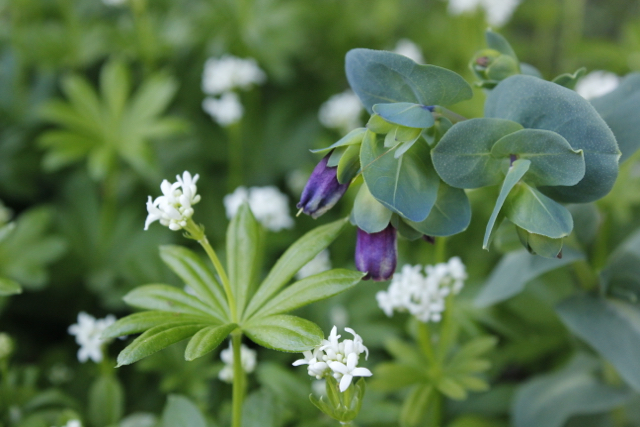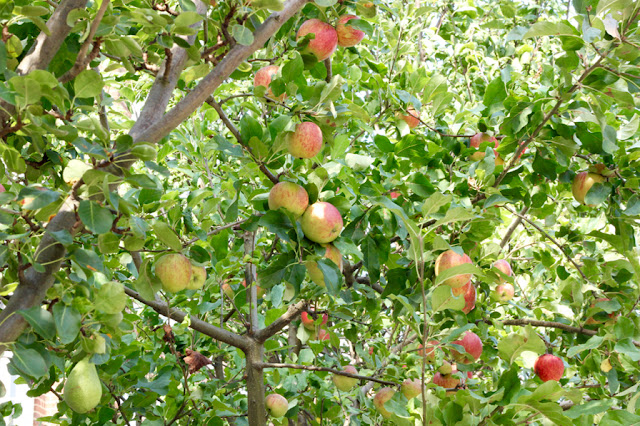 |
| Late September in the veg patch: Verbana hastata and Cerinthe |
Move aside neat and tidy - autumn's here! I love this time of year, not least because the garden looks so pretty, warmed up by the last of the summer sunshine; all the self seeded flowers reach peak autumn vigour and interwine in a riot of colour around the winter veg. A couple of years ago, an artist friend gazed at the mix of geums, nasturtiums and calendula growing under the last of the sweet peas, a few stems of purple Verbena bonariensis and Honeywort poking through above white Feverfew and remarked that he wished he could sit and paint the scene. I had to agree; it looked beautiful.
I realised in the early veg patch days that sowing flowers attractive to pollinators would help to create a healthy balance in the plot. Back then I cleared the beds over winter; the only plants remaining were a few woody herbs and fennel stems into which ladybirds nestled for their cozy winter home. (This year my winter beds are hosting kale, chard, broccoli and oca, as well as herbs.)
 |
| Cerinthe growing up through Sweet Woodruff (Galium odoratum) under the fruit trees |
Those early winter beds weren't empty for long though! The next spring I bought a honeywort (Cerinthe major) seedling during a visit to Sarah Raven's Perch Hill garden and a packet of borage seeds; I didn't know it then but they were the first of my self seeding army.
Some, like foxglove, feverfew, snapdragons and verbena, start to scatter their seed at the slightest puff of wind. I watch borage, calendula, honeywort and poppies for the right moment to collect the seed. (Dried poppy seed heads are beautiful for a wreath or tiny vase indoors.) Nasturtiums will drop so many seed clusters that it's impossible to collect them all, even when harvesting the smallest ones to make Poor Man's Capers - or collecting flowers and seeds for nasturtium vinegar. Ditto for sunflower seeds but first leaves of unwanted seedlings make very tasty additions to spring salad! Try it!
I've learned to identify the plants that I want to keep by the shape of the seedling leaves, removing any that are inappropriately placed. No such thing as a weed? Believe me, these plants can find a tiny crack between bricks or pavers and settle in for the long haul. Feverfew blocking the path? No thanks. Calendula appearing in a sea of spring Forget-me-nots? Yes please! Nasturtiums twining through courgette leaves? Very cheerful!
 |
| Peekaboo! |
At the moment I'm swamped with tiny Verbena bonariensis and V. hastata seedlings; calendula, Linaria, and all those Cerinthe seedlings are also putting in an appearance. A friend has the same with Euphorbia wulfenii seedlings. Another friend turned up with baby Hellebores. We're thinking a plant sale might be A Good Idea.
And another thing ...
If growing self seeders takes your fancy, this is a list of plants I've grown that will self seed freely (or, more likely, prolifically) around the garden. For those averse to surprise flowers, take this list as a warning!Borage
Aquilegia (Columbine, Granny's Bonnet)
Hellebore
Feverfew
Calendula (Marigold)
Verbena bonariensis
Verbena hastata
California poppies (Eschscholzia)
Poppies (Papaver somniferum)
Snapdragons (Antirrhinum)
Verbascum, aka Mullein
Linaria purpurea (Purple toadflax)
Honesty (Lunaria annua)
Teasels (big but great for wildlife)
Nasturtiums
Foxgloves (Digitalis purpurea)
Forget-me-nots (Myosotis sylvatica)
Cowslips (Primula veris)
Violets
Food self seeders:
Orache (Atriplex hortensis rubra)
Physalis, aka Cape Gooseberry
Achocha (Cyclanthera)
Fennel, green and bronze
Wild garlic (ransoms, Allium ursum)
Kale (I leave the flowers for bees to harvest the nectar, then don't always catch all the seed pods)
Tomatoes, if the fruit drops and is left in the soil
Strawberries, via the runners.
Good luck!




